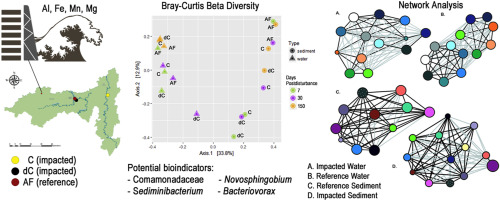当前位置:
X-MOL 学术
›
Chemosphere
›
论文详情
Our official English website, www.x-mol.net, welcomes your
feedback! (Note: you will need to create a separate account there.)
Characterizing a riverine microbiome impacted by extreme disturbance caused by a mining sludge tsunami.
Chemosphere ( IF 8.1 ) Pub Date : 2020-04-01 , DOI: 10.1016/j.chemosphere.2020.126584 Mariana P Reis 1 , Maria Luíza S Suhadolnik 1 , Marcela F Dias 1 , Marcelo P Ávila 1 , Amanda M Motta 1 , Francisco A R Barbosa 1 , Andréa M A Nascimento 1
Chemosphere ( IF 8.1 ) Pub Date : 2020-04-01 , DOI: 10.1016/j.chemosphere.2020.126584 Mariana P Reis 1 , Maria Luíza S Suhadolnik 1 , Marcela F Dias 1 , Marcelo P Ávila 1 , Amanda M Motta 1 , Francisco A R Barbosa 1 , Andréa M A Nascimento 1
Affiliation

|
Studies on disturbance events in riverine systems caused by environmental disasters and their effects on microbial diversity are scarce. Here, we evaluated the impact of the collapse of an iron ore dam holding approximately 50 million cubic meters of waste on both water and sediment microbiomes by deeply sequencing the 16S rRNA gene. Samples were taken from two impacted rivers and one reference river 7, 30 and 150 days postdisturbance. The impacted community structure changed greatly over spatiotemporal scales, being less diverse and more uneven, particularly on day 7 for the do Carmo River (the closest to the dam). However, the reference community structure remained similar between sampling events. Moreover, the impacted sediments were positively correlated with metals. The taxa abundance varied greatly over spatiotemporal scales, allowing for the identification of several potential bioindicators, e.g., Comamonadaceae, Novosphingobium, Sediminibacterium and Bacteriovorax. Our results showed that the impacted communities consisted mostly of Fe(II) oxidizers and Fe(III) reducers, aromatic compound degraders and predator bacteria. Network analysis showed a highly interconnected microbiome whose interactions switched from positive to negative or vice versa between the impacted and reference communities. This work revealed potential molecular signatures associated with the rivers heavily impacted by metals that might be useful sentinels for predicting riverine health.
中文翻译:

表征受采矿污泥海啸造成的极端干扰影响的河流微生物群。
缺乏对环境灾害引起的河流系统扰动事件及其对微生物多样性的影响的研究。在这里,我们通过对16S rRNA基因进行深度测序,评估了容纳约5000万立方米废物的铁矿石大坝的倒塌对水和沉积物微生物群落的影响。扰动发生后第7、30和150天,分别从两条受影响的河流和一条参考河流取样。受影响的社区结构在时空范围内发生了巨大变化,多样性降低且更加不平衡,尤其是在第7天的多卡莫河(最靠近大坝)的时候。但是,抽样事件之间的参考群落结构仍然相似。此外,受影响的沉积物与金属呈正相关。在时空尺度上,分类单元的丰度变化很大,可以鉴定几种潜在的生物指示剂,例如,Comamonadaceae,Novosphingobium,Sediminibacterium和Bacteriovorax。我们的结果表明,受影响的群落主要由Fe(II)氧化剂和Fe(III)还原剂,芳香族化合物降解剂和捕食性细菌组成。网络分析显示,在受影响社区和参考社区之间,微生物群之间的相互作用从正向变为负向,反之亦然。这项工作揭示了与受金属严重影响的河流有关的潜在分子特征,这可能是预测河流健康的有用前哨。我们的结果表明,受影响的群落主要由Fe(II)氧化剂和Fe(III)还原剂,芳香族化合物降解剂和捕食性细菌组成。网络分析表明,在受影响社区和参考社区之间,微生物组之间的相互作用从正向变为负向,反之亦然。这项工作揭示了与受金属严重影响的河流有关的潜在分子特征,这可能是预测河流健康的有用前哨。我们的结果表明,受影响的群落主要由Fe(II)氧化剂和Fe(III)还原剂,芳香族化合物降解剂和捕食性细菌组成。网络分析显示,在受影响社区和参考社区之间,微生物群之间的相互作用从正向变为负向,反之亦然。这项工作揭示了与受金属严重影响的河流有关的潜在分子特征,这可能是预测河流健康的有用前哨。
更新日期:2020-04-01
中文翻译:

表征受采矿污泥海啸造成的极端干扰影响的河流微生物群。
缺乏对环境灾害引起的河流系统扰动事件及其对微生物多样性的影响的研究。在这里,我们通过对16S rRNA基因进行深度测序,评估了容纳约5000万立方米废物的铁矿石大坝的倒塌对水和沉积物微生物群落的影响。扰动发生后第7、30和150天,分别从两条受影响的河流和一条参考河流取样。受影响的社区结构在时空范围内发生了巨大变化,多样性降低且更加不平衡,尤其是在第7天的多卡莫河(最靠近大坝)的时候。但是,抽样事件之间的参考群落结构仍然相似。此外,受影响的沉积物与金属呈正相关。在时空尺度上,分类单元的丰度变化很大,可以鉴定几种潜在的生物指示剂,例如,Comamonadaceae,Novosphingobium,Sediminibacterium和Bacteriovorax。我们的结果表明,受影响的群落主要由Fe(II)氧化剂和Fe(III)还原剂,芳香族化合物降解剂和捕食性细菌组成。网络分析显示,在受影响社区和参考社区之间,微生物群之间的相互作用从正向变为负向,反之亦然。这项工作揭示了与受金属严重影响的河流有关的潜在分子特征,这可能是预测河流健康的有用前哨。我们的结果表明,受影响的群落主要由Fe(II)氧化剂和Fe(III)还原剂,芳香族化合物降解剂和捕食性细菌组成。网络分析表明,在受影响社区和参考社区之间,微生物组之间的相互作用从正向变为负向,反之亦然。这项工作揭示了与受金属严重影响的河流有关的潜在分子特征,这可能是预测河流健康的有用前哨。我们的结果表明,受影响的群落主要由Fe(II)氧化剂和Fe(III)还原剂,芳香族化合物降解剂和捕食性细菌组成。网络分析显示,在受影响社区和参考社区之间,微生物群之间的相互作用从正向变为负向,反之亦然。这项工作揭示了与受金属严重影响的河流有关的潜在分子特征,这可能是预测河流健康的有用前哨。











































 京公网安备 11010802027423号
京公网安备 11010802027423号